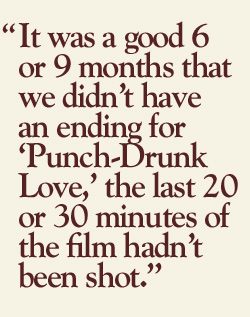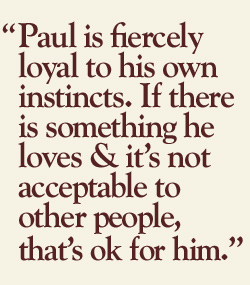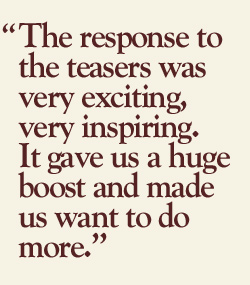Welcome to the fifth installment of
"Making The Master,"
our series of in-depth interviews with some of the minds behind "The
Master." We've spoken to many of the production's principal
players (including
writer/director Paul Thomas Anderson,
producer JoAnne Sellar,
costume designer Mark Bridges and
production designers Jack Fisk & David Crank) that helped bring the film to life and today we have an interview with actress Madisen Beaty. At just 16 years old, Madisen joined the cast as Freddie Quell's long lost love Doris Solstad, a spectre of purity who haunts Freddie throughout the film. She spoke to us about what makes the set of a PTA movie special, what it was like going head-to-head with Joaquin and also reveals the original title for the film.
Enjoy.
Cigarettes & Red Vines: How did you first come to be aware of the film? Had you seen any of Paul’s previous films at that point?
Madisen Beaty: Yeah, I had actually seen part of “Magnolia” and I had seen “There Will Be Blood” and was a huge fan of it. I got an audition, just like any other audition, but it was actually for Amy Adams’ daughter [Elizabeth]. They gave me my sides and I went over them and went in and auditioned with Cassandra [Kulukundis, casting director], and I was in the middle of doing the scene when she stopped me. She was like, “You’re way too young for this.” There was a scene when she’s supposed to drop her robe and she’s like, “You’re 16. You’re not doing that.” And I was so bummed! But before I could even protest that she said, “There’s another role that I think you’d be perfect for so I’m going to give you the sides and you go over them for a sec and then I want to see you do them.” So she gave me the sides and I read them and did them for her. And then I went home and got a call that they wanted me to come and meet with Paul.
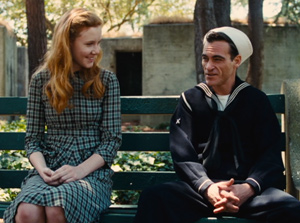
So I went back in and when I got there, they gave me new sides and in these news sides, I’m singing and kissing someone. And they told me that there would be an actor there to read with me. Then they left to go get Paul and Joaquin. So I’m sitting there freaking out, going “Oh my gosh.” I know that’s Joaquin and I’ve seen all his stuff online and I’m supposed to kiss him and I’m singing? What is this! So they came in and Paul introduced himself and then Joaquin introduced himself. And we did these new scenes and I was freaking out. Then I didn’t hear anything for like 2 weeks and then I heard that I got it. I remember later I was talking to Joaquin on set and was like, “Those were the longest two weeks of my life, you don’t understand!” And he goes, “Yeah, I kept asking Paul, ‘Did you tell her that she got the role?’ and he was like, ‘Yeah, I’ll get to it.’” [laughs] He’s just very relaxed in his whole process.
So it was just those two auditions that got you the role?
Yeah. Something interesting is [during the second audition] when we got to the scene where I’m supposed to sing
“Don’t Sit Under The Apple Tree (With Anyone Else But Me)” by The Andrews Sisters. And I didn’t know the song at the time so when I got there, I told them, “I can go learn it and come back or I can sing something else for you. I don’t sing professionally, but I can sing okay.” And Paul was like, “Yeah, we’ll just skip that.” As we were filming I kept asking him, “Do you want to hear me sing?” And he was like, “No, we’ll get to it Madisen. It’s okay.” So fast-forward, it’s the day of filming the scene and I’m not joking, no one had heard me sing.
I’ve been working on it and practicing and even my parents hadn’t heard me. So we started rolling and I started singing and my dad described it, it was just shock on the set because no one knew that I could sing. So we did two or three takes but Paul wasn’t coming up to me. So finally I walked up to him like, “Paul, you gotta tell me. Is it good? I’m just singing! You didn’t give me anything.” And he goes, “Madisen, I figured either Doris would sing and it’d be kind funny and cute because she thinks she can sing but she can’t and she’s just letting Freddie in on her world. Or she’d sing like you did. And you should keep going.” I still can’t believe it to this day.
That must have been incredibly nervewracking.
I was pretty nervous but Paul’s set -- you hear people talk about it -- but it’s really just a different experience.
 Did you have any idea that it would make it onto the soundtrack?
Did you have any idea that it would make it onto the soundtrack?
No, never in a million years. I was driving to an audition one day and my mom called me and said, “You might want to go online,” so I pulled up my phone and saw that I was on the soundtrack. It was very weird for me.
Did you get the entire script at some point or just the pages of scenes that you were in?
I just had the pages I was going to be in. I was bugging Paul and kept asking him, “Can I read the script? I’ll give it right back.” He said, “I just want you to know what Doris knows and I want to keep it that way.” And I thought that was just a Paul thing where he just lets you see what your part of the script is but now I know that Doris wasn’t even in the first couple drafts.
So did you not know what was going on in the rest of the film until you saw it for the first time?
I had no idea. All I knew was Doris. It’s interesting because she’s haunting Freddie throughout the entire film and the way they set it up to film, we did the screen test -- the screen test was me and Joaquin -- and the first week and a half of filming was me and Joaquin. Then that was a wrap for me so I left but I think Paul set that up so that the whole time, Joaquin could be pulling from that [experience]. Then they called me back about 2 months later and said that they added some scenes and wanted me to come back. This time I filmed in LA instead of San Francisco and when I came back it was so weird because Joaquin was different. The chemistry was a little off and I think it was because he’s such a method actor and he hadn’t seen me during that time.
So what was the scene you came back to film?
It’s hard to tell in the movie, you might get to see some more when the DVD comes out which is supposed to have some deleted scenes. But anything in the movie theatre, I just went and filmed in this gorgeous movie theatre downtown LA. The scene is when we’re sitting on the steps and it’s actually when I’m singing. Paul had me sing again and cut the first time I sing. We kinda redid a little bit of everything and talked about some more things. Then a lot of the scenes that we did in San Fran didn’t make the cut. But Paul’s so gracious that in the trailer [
teaser #3], you see some of those deleted scenes.
How did you and Paul develop the character of Doris? In an earlier draft of the script, she’s referred to but has no scenes but clearly he had something else in mind in fleshing out the character.
We stuck to the sides at first and then when we actually got on set it was very free flowing and everything came out organically where we started going off script. I knew enough about Doris and Joaquin knew about Freddie and we would go way, way off script. Paul was so open to that. One morning we were filming a scene where Joaquin had just come back from the war and we’re sitting on the park bench. We were very flirty and we kissed and all that. Then we went to lunch and when we came back -- this was a scene that didn’t make the cut -- but we were fighting because I’m too young for him. Between takes Joaquin was cussing and kicking things and walking around and yelling at me and I was so confused.
While he’s doing that, Paul was like, “This is great! This is so great.” [laughs] And my 16 year old mind is just freaking out, I was so confused until finally I was like, “Paul, I’m so confused. You know I trust you but Joaquin’s over there and you’re over here.” And he goes, “Madisen, that’s Freddie. You’re Doris. You are down here and he’s bringing you down and you need to be bringing him up.” And all of a sudden it clicked where he’s not going to go and tell Joaquin to stop. So I walked back and was like, “Freddie, it’s okay.” And I started talking about how everything was going to be fine and the scene was completely different. Just having that control to be able to make the scene whatever I wanted to make it, I’ve never experienced that before and I don’t think I will for a long, long time. And it’s all Paul.
That kind of freedom must be great for an actor.
Oh, it’s wonderful. When you put him and Joaquin together, they’re both just so focused and there’s no limits for either of them. I think that’s what makes it so brilliant because there are no limits and when you don’t limit yourself, brilliant things come out.
All of your scenes in the film were with Joaquin, did you have any scenes with any of the other actors that didn’t make the cut?
There was definitely more with my mom [Mrs. Solstad played by Lena Endre]. There was a scene where I’m asking her to go out and they taught me how to say something in Norwegian that didn’t make it into the final film. But for the most part everything was focused on Joaquin. Something that never came out in the film, everyone always wonders how Freddie and Doris know each other. My character’s older brother was his friend growing up and they both went to war together. My older brother died in the war so Freddie was coming back to pay respects slash bring out this unspoken love because I’d been writing him these letters.
Were there any other Doris scenes that didn’t make it into the film?
Just the scene where we were fighting because of the age difference and how it wouldn’t work even though I wanted to make it work. When I first saw the cut I was so disappointed that it didn’t make it into the film but now looking back I’m really glad that it didn’t because when you watch it now, it’s like we’re not together because he couldn’t handle Doris’ love. Which I think is a better story than the age difference and it definitely makes it a different story.
You’ve already talked a bit about it but can you just describe what it was like as a young actress working with Joaquin who is just a force of nature in the film?
There’s really no limits for him. He’ll go off script and he’ll do his own thing. If he’s mad, he’s going to be really, really angry like, kicking the park bench. I think he even pulled it out of its root and kicked the park bench off the thing. [laughs] There’s just no limits, he’ll do anything. The scene where he comes and wakes me up when I’m sleeping...
 When he tears the window screen out.
When he tears the window screen out.
Yes. That was one of my favorite days of filming because both him and Paul were playing tricks on me. It’s was like 3am when I got to set and I’m awake as ever. Paul told me, “You are just way too awake,” as we were leaving the hotel. I was like, “Hi Paul! How are you? It’s 3am!” But I’m 16 so I don’t know what you would expect. So he said, “I want you to get to set. Don’t even go to makeup. Get in costume but don’t do anything else and I’ll meet you there.” So I got in costume and went to set and he walked me through the house and took me back to what was Doris’ room. And he said, “I know you don’t believe me but we’re not going to be filming for like an hour and I want you to just lay down and go to sleep. I’ll come wake you up before we film.” I was like, “Are you sure you’re going to wake me up?” He said, “Yeah, just go to sleep.”
My mom told me that as I forced myself to go to sleep, they closed the door and Paul told the crew to be quiet because I was sleeping. I’m just thinking about what the crew must be thinking of me working and I’m sleeping on the job! Then I woke up to this knocking and sat up and thought it was the door. Then I realized that Joaquin was at the window and thought, “Oh, I must’ve not heard them waking me up.” So I just went with it and did the scene. He was just supposed to kiss me but then he pulled off the screen and it became what you see. I’m pretty sure the take that you see is that first take when I had just woken up because of the way that I say the lines. I was so confused because I had just woken up.
So it did work!
[laughs] Yeah. As we went on filming and did a couple other takes, they had to take screens from around the house to keep going because he kept ripping the screens off. But that’s just Joaquin, he doesn’t care. He does what feels right and I followed that and I did what felt right. I think it’s the best way to bring a character to life because there’s no limits. That’s what you do in real life so when you see that onscreen, there’s something that’s so different about it that’s organic. That’s what’s so beautiful about Paul’s films because every single one of his films has that natural energy that is whatever you want it to be.
So what makes the set of a PTA movie different from any other set that you’ve been on?
There are sets that you go on where the crew just doesn’t work together, it’s like a puzzle where the energy is thrown off because these people don’t know each other and they’ve never worked together and different people don’t always mix well. One of the best things about Paul’s set is that he brings together everyone who he’s worked with before. Of course, there are some new people but most of them are people that he’s worked with for years. To see the crew work together and work so effortlessly and so naturally is great.
I remember coming back to the hotel from filming and there was a group of his crew hanging out in the lobby drinking wine together. They were like, “Madisen! Come on over here, bring your mom. Let’s talk!” We sat in the lobby with some of his crew and just shared stories. They’re so wonderful and they don’t get the recognition they deserve. Paul is so direct and he knows what he wants but he says it in a way where you have control. When Joaquin was angry and he pulled me aside, he didn’t go up to Joaquin and give him direction. He let me go up to him and kinda tweak it just a little bit so that the scene was different. Having that control is so empowering and him letting everyone do their own job and bring it together so effortlessly is what makes his sets so amazing.
Can you think of any other moments that stand out as being memorable or any stories you’d want to share?
Aside from filming, the experience I had afterwards [was definitely memorable]. I hoped I would get to go to the premiere but you never know how these things work. I was fortunate enough to be invited to Venice and after that to go to TIFF and after that to the New York premiere. That whole experience was absolutely amazing. Me and my mom and my manager went to Venice. It was a girls weekend and I’d barely been out of the country before! I’d seen the movie in LA with my dad before and I honestly didn’t like it at first. But it’s one of those films where you have to let it sit. Seeing it a second time, I fell in love with it.
I think part of it was sitting there [in Venice] with this audience that was reacting to everything, next to Joaquin and Phil [Seymour Hoffman] and Paul and Harvey [Weinstein] and JoAnne [Sellar] and Megan [Ellison]. Sitting there and watching the film with these people, it was this weird moment where it was like, “I don’t belong here. But I do.” Afterwards there was a standing ovation where me, Phil and Joaquin were standing and the whole theatre is turned to us and clapping. It was this weird moment because this is
their film. I am a part of it definitely, but this is their film and they’re the ones who created it. So I kinda stepped to the side and Phil came over to me and grabbed my hand and pulled me back up and said, “You belong with us now, darling.”
That’s great.
That moment for me, was amazing. I might not have created this film but I’m a part of it and that goes back to the family that Paul creates with his crew. The way he makes everyone feel like they belong and it’s just a family that just is in it together. That’s really hard to do. I’ve been on so many sets where it’s not even comparable, none of them are comparable to Paul’s sets.
I know that the film didn’t land on a title until pretty late in the process. Were there any working titles along the way?
It was originally called “The Cause” but we weren’t supposed to say that obviously because it was [supposed to be kept] really quiet. When we were filming in San Francisco, wherever we went they were calling it the “Untitled Western” so no one knew who we were. But to everyone else it was known as “The Cause.” Whoever was aboard at the beginning of filming even got a shirt and a flask in the mail saying “Thank you for joining the production.” The flask said “The Cause” and the shirt had this little logo that said “The Cause.” I thought, “Oh, how cool. I’m going to get to wear this when it comes out.” Then they changed the name! But I like “The Master” better because I feel like it evolved and just from what scenes made it [into the film]. Paul had a story in his head and it definitely evolved as we filmed but I think what came out was better than what we had in the beginning.
Can you talk a little bit more about your first reaction to the movie, since you’d only really known about your piece of it, it must have been pretty crazy to finally see the whole thing.
I had 5 or 6 scenes and we filmed all of them but I didn’t know what would make it or how he would edit it. I originally sang in San Francisco on the front steps of my house but when you see the movie, I’m singing in the movie theatre [in LA]. So for me it was confusing because I wasn’t sure how it was going to translate to the film. My dad was guessing that maybe he’s just haunted and he’s imagining me in the movie theatre there with him. We knew that he got drunk because I had accidentally seen some other sides. [laughs] So when I finally saw it though I was able to follow it, it was still very confusing.

I don’t think it’s a film that you can watch once because there’s so much going on and so many underlying themes. So I wasn’t really sure if I was happy with what had been used, as far as my scenes go but then when I saw it the second time, I was able to watch it as an audience member instead of as an actor. Now I’ve seen it probably 5 or 6 times and still catch these little things. I’m really happy with what came out of my role now and think it’s best for the story. Paul was so nice to include some of the deleted scenes in the trailers he put out and I hear there’s going to be more on the DVD.
Did you have conversations with Paul about what the film was about or would he only really discuss what your piece of it was?
He was very conscious that I would only be focused on Doris and Freddie. Like I said, the first two weeks of filming and the screen test was Freddie and Doris. It was very focused on their relationship and how innocent and beautiful that it was. When I came back to set [2 months later] the energy was completely different. I know they had been doing some harder scenes and accidentally saw some sides of when he’s in the theatre drunk and The Master calls him. In the sides that I saw, The Master said, “Did she get to you Freddie? Did she get to you?” So I thought, “Oh it’s Doris. Maybe my character is haunting him the entire time and maybe that’s one of the themes of the movie.” But I really had no idea.
I kept asking Paul --I was probably the most annoying kid because I just kept asking him, -- “Am I the inciting incident? Am I the lock in?” if we’re talking script terms and he would not tell me. All he said was, “You are what Freddie wants and that’s what you need to remember. You are what’s pure to him and you are what keeps him anchored. You are the only one that has the control to have such a spell on him.” And to see what Joaquin did with that character once I got on set, it’s obviously Joaquin Phoenix but working with him is something completely different. And you have Phil and Amy and in person they’re all so wonderful. For me, as a young actor, it was an incredible experience and I was able to grow so much.
You’ve already worked with another especially notable director, David Fincher on “The Curious Case Of Benjamin Button,” so I was just wondering if there were any similarities or differences in their approach with actors?
I love them both and they’re very different! [laughs] David is very focused on the little details -- it’s like the most miniscule things -- and he’s very set on the sides being the way they’re written. As you know he has a reputation for doing things 50 times over but I asked him about it and he said he does that so that we forget what we’re saying and focus more on the emotion. With Paul you start with the emotions and then the lines come instead of forgetting that they’re lines. They’re very different in the way that they work but they’re both so brilliant. A similarity is that you can see when they’re studying the monitor, they both have this love and they’re such perfectionists about it. But they’re so different in the way that they film and the way that their sets are run.
Are there any other directors on your wish list now that you’ve crossed these two off your list?
I remember wrapping ‘Benjamin Button’ and talking to my mom asking, “Well, what do I do now?” After that I went on auditions for smaller projects and for me it was an adjustment because I kinda got a big head working on that film. [laughs] It was like, “I’m gonna have this awesome career,” and then you go and do some other things. I did a Lifetime movie and there was the writers strike and then “The Master” came. And well, we thought we couldn’t do better but look, we’re still going. I don’t want to say too much but I definitely would love to work with obviously, Quentin Tarantino and Wes Anderson and more recently, David O. Russell. I love the directors that have their own language. With David and Paul, they both have their own language. And “Django [Unchained]” has got to be one of my favorite movies now. To see that, that is why I act: it’s the art of telling stories. When you meet artists who tell the stories in their own language, there’s something so beautiful about that. That’s what I love about it and that’s who I want to work with.
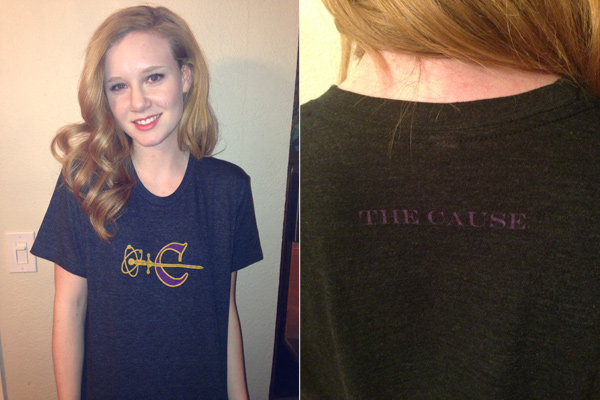
Pre-order "The Master" on Blu-ray or DVD.
Stay tuned to Twitter and Facebook for the latest news and updates.














